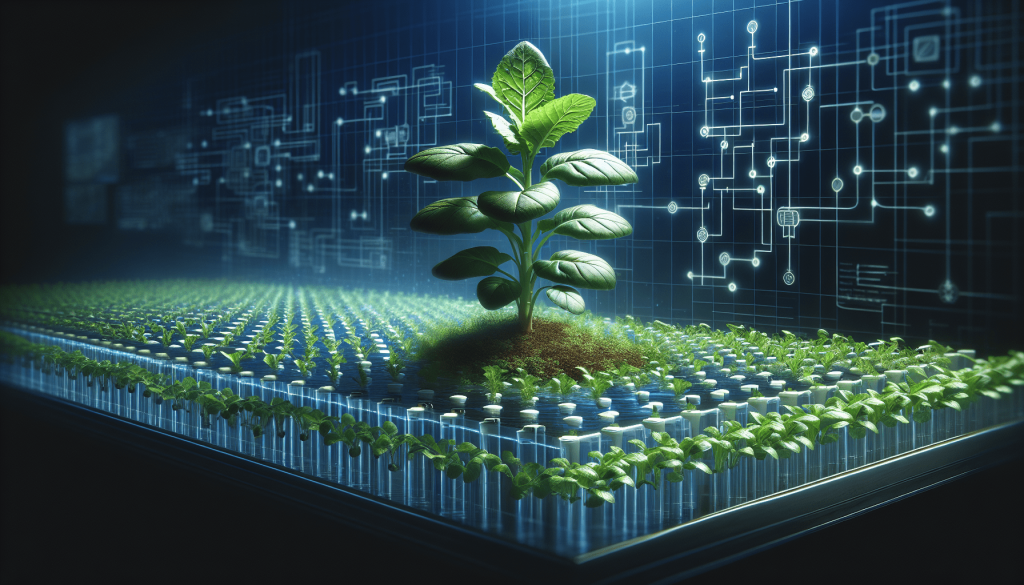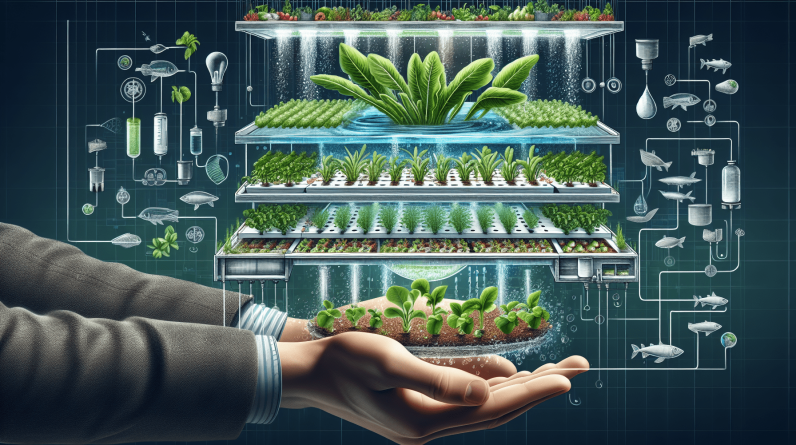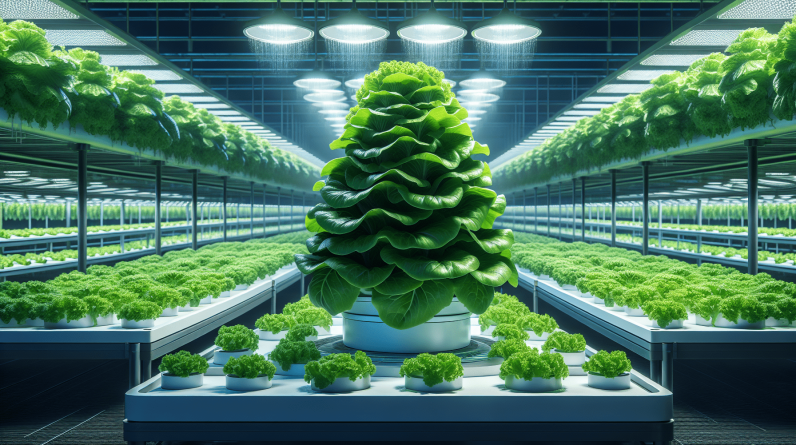
You’ve heard about the buzz surrounding hydroponic farming, but have no idea where to start? Look no further! In this informative guide, we will take you through the basics of hydroponic farming, making it easy for anyone, regardless of their gardening experience, to get started. From choosing the right system to understanding the importance of nutrients and lighting, we’ve got you covered. Join us as we explore the wonderful world of hydroponic farming and discover how you can grow your own crops all year round, regardless of climate or space limitations. Get ready to embark on a green journey like no other!
What is Hydroponic Farming?
Definition and Explanation
Hydroponic farming is a method of growing plants without the use of soil. Instead, plants are grown in a nutrient-rich water solution that provides all the necessary elements for their growth. This innovative approach to agriculture has gained popularity in recent years due to its numerous advantages over traditional soil-based farming methods.
History of Hydroponics
The concept of hydroponics dates back thousands of years to ancient civilizations such as the Babylonians and the Aztecs who practiced a rudimentary form of hydroponic farming. However, it wasn’t until the 19th century that modern hydroponics came into existence. In the 1930s, researchers discovered that plants could be grown successfully in water solutions containing the necessary nutrients. Since then, hydroponics has evolved and become a widely recognized and efficient method of agriculture.
Advantages of Hydroponic Farming
Water Efficiency
One of the biggest advantages of hydroponic farming is its exceptional water efficiency. Unlike traditional farming methods, hydroponics requires only a fraction of the water needed for soil-based agriculture. The water used in a hydroponic system is constantly recycled, making it incredibly sustainable and environmentally friendly.
No Soil Required
Another major advantage of hydroponic farming is that it eliminates the need for soil. This means that you can grow plants in a controlled environment, free from soil-borne diseases and pests. Hydroponics also enables you to cultivate plants in areas where the soil quality is poor or limited, such as urban settings or regions with adverse climate conditions.
Reduced Pests and Diseases
By growing plants hydroponically, you can greatly reduce the risk of pests and diseases that commonly plague traditional soil-based farming. Since hydroponic systems are sterile environments, pests and diseases that thrive in soil are less likely to affect your crops. This eliminates the need for chemical pesticides, making hydroponic farming a healthier and more sustainable option.
Better Control over Nutrient Levels
One of the key benefits of hydroponic farming is the ability to have precise control over the nutrient levels that plants receive. In a hydroponic system, nutrients are directly provided to the plants’ roots, ensuring that they receive the optimal balance of essential elements. This allows for faster growth, increased yields, and healthier plants overall.
Year-round Growing
Hydroponic farming allows for year-round growing, regardless of the season or climate. With the right equipment and lighting, you can create an artificial environment that provides the ideal conditions for your plants to thrive. This means that you can produce crops consistently throughout the year, providing a reliable source of income and fresh produce.

Basic Components of a Hydroponic System
Growing Medium
In a hydroponic system, the growing medium serves as a support structure for the plants’ roots. It helps anchor the plants and provides stability. Common growing mediums used in hydroponics include rockwool, perlite, coco coir, vermiculite, expanded clay pellets, peat moss, sand, and gravel. The choice of growing medium depends on factors such as the type of crop being grown and personal preference.
Nutrient Solution
The nutrient solution is a crucial component of a hydroponic system as it provides all the necessary elements for plant growth. It consists of water that is enriched with a balanced mix of essential nutrients, including nitrogen, phosphorus, potassium, calcium, magnesium, and trace elements. These nutrients are essential for the plants to carry out their metabolic processes and develop properly.
Water Reservoir
The water reservoir is where the nutrient solution is stored in a hydroponic system. It needs to be large enough to hold an adequate amount of water to sustain the plants’ growth. The size of the reservoir will depend on the scale of your hydroponic operation and the number of plants you are growing.
Pump and Tubing
A pump and tubing are used to circulate the nutrient solution from the water reservoir to the plants. The pump ensures that the solution is adequately distributed throughout the system, providing each plant with the necessary nutrients. Tubing is used to connect the different components of the system and create a continuous flow of the nutrient solution.
Light Source
Since hydroponic systems are often located indoors or in controlled environments, artificial lighting is necessary to provide the plants with the energy they need for photosynthesis. High-intensity discharge (HID) lights, LED lights, or fluorescent lights are commonly used in hydroponic farming to mimic natural sunlight. The type and intensity of the light source will depend on the specific requirements of the plants you are growing.
pH Control
Maintaining the correct pH level is crucial for the success of a hydroponic system. The pH scale measures the acidity or alkalinity of the nutrient solution. Most plants prefer a slightly acidic pH range between 5.5 and 6.5. To ensure optimal nutrient uptake, it is important to regularly monitor and adjust the pH level using pH testing kits and pH adjusters.
Air Circulation
Proper air circulation is essential for hydroponic systems as it helps deliver oxygen to the plants’ roots and prevents the buildup of excess humidity. Fans and air pumps are used to maintain a steady flow of fresh air within the growing area. This is especially important in enclosed or indoor hydroponic setups where natural air movement may be limited.
Temperature Control
Maintaining the right temperature is vital for the health and growth of the plants in a hydroponic system. Different plants have different temperature requirements, but in general, a temperature range between 65°F and 75°F (18°C and 24°C) is suitable for a wide variety of crops. To achieve optimal temperatures, heating systems, cooling systems, and ventilation may be used.
Different Types of Hydroponic Systems
Deep Water Culture (DWC)
Deep Water Culture (DWC) is a simple and popular hydroponic system that involves suspending the plants’ roots in a highly oxygenated nutrient solution. The roots are submerged in the solution, promoting rapid growth and efficient nutrient absorption.
Nutrient Film Technique (NFT)
Nutrient Film Technique (NFT) is a hydroponic system in which a thin film of nutrient solution flows continuously over the plants’ roots. The roots are exposed to the solution, allowing for efficient nutrient absorption while maintaining oxygenation.
Drip System
A drip system is a hydroponic system where the nutrient solution is dripped onto the plants’ roots through small tubes or emitters. It is a versatile and widely used system that allows for precise control over nutrient delivery.
Ebb and Flow (Flood and Drain)
Ebb and Flow, also known as Flood and Drain, is a hydroponic system that periodically floods the plant roots with the nutrient solution and then drains it away. This cyclic flooding and draining provide a balance of water and oxygen to the roots.
Aeroponics
Aeroponics is an advanced hydroponic system that involves suspending the plants’ roots in a mist or fog of nutrient solution. The roots are kept moist while being exposed to high levels of oxygen, leading to rapid growth and increased nutrient uptake.
Wick System
The wick system is one of the simplest hydroponic systems and does not require any pumps or moving parts. The plants’ roots are in direct contact with a growing medium, and a wick draws the nutrient solution from the reservoir to the roots.

Choosing the Right Hydroponic System for You
Space Requirements
Before deciding on a hydroponic system, consider the space you have available. Some systems, like deep water culture or aeroponics, require more vertical space due to the roots being suspended in water or mist. Other systems, such as a drip system or wick system, may be more suitable for smaller spaces.
Budget
Your budget will also play a significant role in determining the type of hydroponic system you choose. Some systems, like deep water culture or aeroponics, may require more initial investment due to the need for specialized equipment, such as air pumps or misting devices. On the other hand, simpler systems like a wick system or drip system can be more budget-friendly.
Level of Automation
Consider how much time and effort you are willing to invest in maintaining and operating your hydroponic system. Some systems, like aeroponics or nutrient film technique, may require more regular monitoring and adjustment of nutrient levels. Alternatively, systems like a wick system or ebb and flow system can be more hands-off and require less maintenance.
Types of Crops
Different hydroponic systems are better suited for growing specific types of crops. For example, leafy greens and herbs thrive in nutrient film technique or deep water culture systems, while larger flowering plants may require a drip system or ebb and flow system to support their growth. Consider the types of crops you plan to grow and choose a system that can accommodate their specific needs.
Selecting the Ideal Growing Medium
Rockwool
Rockwool is a popular growing medium in hydroponic farming due to its excellent water retention and air porosity. It provides a stable structure for plant roots while maintaining proper moisture levels.
Perlite
Perlite is a lightweight and sterile growing medium that promotes good drainage and aeration. It is often used in combination with other growing mediums to improve their properties.
Coco Coir
Coco coir, made from the husk of coconuts, is a sustainable and versatile growing medium. It has excellent water retention, good aeration, and high nutrient-holding capacity. Coco coir can be used alone or mixed with other growing mediums.
Vermiculite
Vermiculite is a lightweight and sterile growing medium that improves water retention and aeration. It is often used in seed starting or propagation trays.
Expanded Clay Pellets
Expanded clay pellets, also known as hydroton, are lightweight and provide good aeration for plant roots. They are reusable and help prevent waterlogging in the growing medium.
Peat Moss
Peat moss is a natural and acidic growing medium that holds moisture well. It is often used in combination with other growing mediums to improve water retention.
Sand
Sand is a common and inexpensive growing medium that provides good drainage. It is often used in hydroponic systems where aeration is necessary.
Gravel
Gravel is a durable and inorganic growing medium that promotes good drainage. It is commonly used in larger hydroponic systems or systems that require support for larger plants.

Understanding Nutrient Solutions
Essential Nutrients for Plants
Plants require essential nutrients for their growth and development. These nutrients can be divided into two categories: macronutrients and micronutrients. Macronutrients, such as nitrogen, phosphorus, and potassium, are required in larger quantities, while micronutrients, such as iron, zinc, and manganese, are needed in smaller amounts. Balancing these nutrients is crucial for healthy plant growth.
Managing pH Levels
pH levels play a vital role in nutrient uptake and overall plant health. Most plants prefer a slightly acidic pH range between 5.5 and 6.5. Regularly monitoring and adjusting the pH level of the nutrient solution is essential to ensure optimal nutrient uptake by the plants.
Balancing Nutrient Concentrations
Maintaining the correct nutrient concentrations is crucial for plant growth. Too high or too low nutrient concentrations can lead to nutrient deficiencies or toxicities. Regularly monitoring nutrient levels and adjusting the nutrient solution accordingly is necessary for healthy plant development.
Pre-made Nutrient Solutions vs. Mixing Your Own
There are two options when it comes to nutrient solutions: using pre-made nutrient solutions or mixing your own. Pre-made nutrient solutions are convenient and formulated to provide the necessary nutrients for different growth stages. However, some growers prefer to mix their own nutrient solutions to have more control over nutrient concentrations and customize the solution to their specific crops’ needs.
Maintaining the Hydroponic System
Monitoring pH and Nutrient Levels
Regularly monitoring the pH and nutrient levels of the hydroponic system is essential for plant health. Use pH test kits and nutrient testing meters to ensure that the pH remains within the optimal range and nutrient levels are balanced. Adjustments can be made by adding pH adjusters or specific nutrient solutions as needed.
Cleaning and Disinfecting
Maintaining a clean and sterile environment is crucial in hydroponic farming to prevent the growth of harmful pathogens and diseases. Regularly clean and disinfect all components of the system, including the reservoir, growing medium, and equipment, to minimize the risk of contamination.
Preventing Algae Growth
Algae growth can be a common issue in hydroponic systems, especially if light is allowed to penetrate the nutrient solution. To prevent algae growth, ensure that the nutrient solution is kept in a dark environment and light-proof the reservoir if necessary. Regularly monitor and clean any visible algae to maintain the health of your plants.
Replacing Water Regularly
While hydroponic systems recycle water, it is important to replace the nutrient solution periodically. This helps maintain the balance of nutrients and prevents the buildup of harmful substances. As a general guideline, replace the nutrient solution every 1-2 weeks or as recommended for your specific crops.
Inspecting and Servicing Equipment
Regularly inspecting and servicing your hydroponic equipment is crucial to ensure proper functioning and prevent any potential issues. Check for leaks, clogs, or any signs of wear and tear in the pumps, tubing, and other components. Clean or replace any faulty equipment promptly to maintain the efficiency of your system.

Common Challenges and Troubleshooting
Nutrient Deficiencies
Nutrient deficiencies can occur in hydroponic systems if the nutrient solution is not properly balanced or if plants are not receiving adequate amounts of specific nutrients. Common nutrient deficiencies include nitrogen deficiency, phosphorus deficiency, and iron deficiency. Regular monitoring, proper nutrient balancing, and adjusting the nutrient solution accordingly can help prevent and address nutrient deficiencies.
Pests and Diseases
Although hydroponic systems reduce the risk of pests and diseases, they are not entirely immune. Some common pests that can affect hydroponic crops include aphids, spider mites, and whiteflies. Vigilance, regular inspection, and implementing appropriate pest control measures, such as introducing beneficial insects or using organic pesticides, can help control pests and prevent their spread.
Root Rot
Root rot is a common issue in hydroponic systems and occurs when the roots are continuously exposed to excess moisture or insufficient oxygen. This can lead to the growth of harmful fungi that damage the roots. To prevent root rot, ensure proper drainage, maintain appropriate oxygenation, and regularly inspect the roots for any signs of rot or decay.
Temperature Fluctuations
Temperature fluctuations can have a significant impact on the growth and health of plants in a hydroponic system. Extreme temperatures can lead to stress, reduced nutrient uptake, and slower growth. Maintaining a stable temperature within the ideal range for your specific crops is essential. Use heating or cooling systems, as well as proper ventilation, to control temperature fluctuations.
Clogged Plumbing
Clogging of plumbing is a common issue in hydroponic systems, especially in systems that use small tubes or emitters for nutrient delivery. The buildup of mineral deposits, algae, or debris can restrict the flow of the nutrient solution, leading to uneven nutrient distribution or plant stress. Regularly flushing the system, checking for clogs, and cleaning or replacing plumbing components can help prevent this problem.
Tips for Successful Hydroponic Farming
Start with Simple Crops
If you’re new to hydroponic farming, it’s a good idea to start with simpler crops that are easier to grow and maintain. Leafy greens, herbs, and small fruiting plants like cherry tomatoes are great options for beginners. Once you gain experience and confidence, you can gradually expand your crop selection.
Maintain a Daily Routine
Consistency is key when it comes to hydroponic farming. Establish a daily routine that includes checking pH and nutrient levels, inspecting plants for any signs of stress or disease, adjusting the nutrient solution as needed, and maintaining proper temperature and humidity levels. Regular monitoring and adjustments will help ensure the success of your hydroponic system.
Proper Lighting and Light Duration
Lighting is crucial for plant growth in a hydroponic system. Ensure that your plants receive adequate and appropriate light by using the correct type and intensity of artificial lighting. Different crops have different light requirements, so research the specific lighting needs of the plants you are growing. Additionally, establish a consistent light duration that mimics natural daylight patterns to avoid disrupting the plants’ growth cycle.
Temperature and Humidity Control
Maintaining the correct temperature and humidity levels is vital for the success of your hydroponic system. Monitor and adjust the temperature and humidity using heating and cooling systems, as well as ventilation. This will help create an optimal growing environment and prevent stress on the plants.
Regularly Monitor and Adjust the System
Regular monitoring and adjustment of your hydroponic system are crucial for optimal plant growth. Keep track of pH and nutrient levels, inspect plants for any signs of nutrient deficiencies, pests, or diseases, and adjust the nutrient solution and other environmental factors as needed. By staying proactive, you can address any issues early on and ensure the health and productivity of your hydroponic farm.
In conclusion, hydroponic farming offers numerous advantages over traditional soil-based agriculture, including water efficiency, reduced pests and diseases, better nutrient control, and the ability to grow crops year-round. By understanding the basic components of a hydroponic system, choosing the right system for your needs, selecting an ideal growing medium, and properly managing nutrient solutions, you can successfully maintain a hydroponic farm. Regular maintenance, troubleshooting common challenges, and following helpful tips will further enhance your chances of success in this innovative and sustainable farming method.








